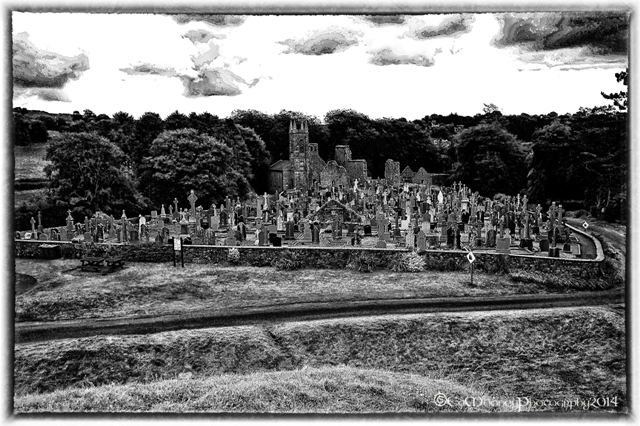Last weekend I made the long trip down to the southern tip of County Carlow to explore the monastic settlement of St. Mullins. Writing this and looking back Im not sure what I had expected to find, but It did turn out to be much more than I realized. It’s a fantastic Ecclesiastical site with numerous antiquities both within the grounds and nearby. So much in fact I have decided to break them up into individual posts, similar to what I had to do with my recent exploration of the Monastic City of Glendalough. As it turns out, it celebrated the 1400 year anniversary of St. Mullin yesterday. The site consists of a sub-rectangular graveyard located on high level ground with the river Barrow to the West. Originally known in Gaelic as Tigh Moling, meaning House of Moling. St. Moling was believed to have been born in 614 in Sliabh Luachra in Kerry.
According to tradition he was said to have been a descendant of Catahair Már whom was a Prince of Leinster. It is said that he studied to be a monk down at the Ferns monastery in County Wexford and also as a monk in Glendalough. With some assistance, most likely financial from Maedoc of Ferns he founded his monastery at Achad Cainigh, which became Teach Moling or St. Mullins in the 7th century. The monastery was said to have been built with the help of “Gobban Saor”, the legendary Irish builder. Mullin eventually went on to become the Archbishop of Ferns in 691. During his lifetime he was said to have preformed many to miracles. And was credited with freeing the people of Leinster from paying the Borumean Tribute the High King of Ireland. Over the course of several years he was credited with digging a mile long watercourse with his own hands to power his mill. The watercourse is still there but the original monastery received a visit from those friendly Vikings in 951AD and again in 1138AD, when it was burnt. He died in 697 and is buried at St. Mullins. There is a lot of interesting history and buildings here which I will post about over the next few days. I really hope you enjoy them as much as I did exploring.
Check out the other antiquities to be found Here.
St. Mullins Heritage Center
Ard Chros Naomh Moling
An Teampall Mór
The Mill Stone
The Abbey
The Stump
St. James Cell
The Oratory – Resting Place of a King
Mullins Domestic Building
For these and more of my images, why not visit my Website or join me on Facebook or Twitter.





Looking forward to your posts Ed!
LikeLike
Thanks Ali 🙂
LikeLike
Year 614! AMAZING.
LikeLike
And still standing 🙂
LikeLike
yes, that really is incredible!
LikeLike
Beautiful picture! Thank you for sharing!
LikeLike
Thank you, glad you liked it 🙂
LikeLike
Fascinating place, thank-you for sharing the history and the great photo!
LikeLike
My Pleasure Mary, got plenty more from here later on this week 🙂
LikeLike
St Mullins is where the mad bird-King Sweeney found peace of mind, and eventually his death on the spear end of the swineherd. This last was prophesied by St Ronan when Sweeney clashed with him and was subsequently cursed.
LikeLike
Hi Michael,Interesting story. Is there any source info for this that I could research?
LikeLike
Seamus Heaney was the last to translate Sweeney in 1983, Sweeney Astray. His work was based on the O’Keefe translation. It’s all in there.
LikeLike
Just going through it now, fascinating stuff. I wonder how much of the story is real 🙂
LikeLike
All of it, surely (;-))
LikeLike
🙂
LikeLike
Its cool, I found some references, A very interesting tale. Thanks for pointing it out to me, I will try to work it in one of my posts 🙂
LikeLike
Pingback: The Mill Stone | EdMooneyPhotography
Pingback: The Bath | EdMooneyPhotography
Pingback: Teampall na Bó | EdMooneyPhotography
Pingback: Black Castle | EdMooneyPhotography
Pingback: Capturing History Challenge – Week 7 | Ed Mooney Photography